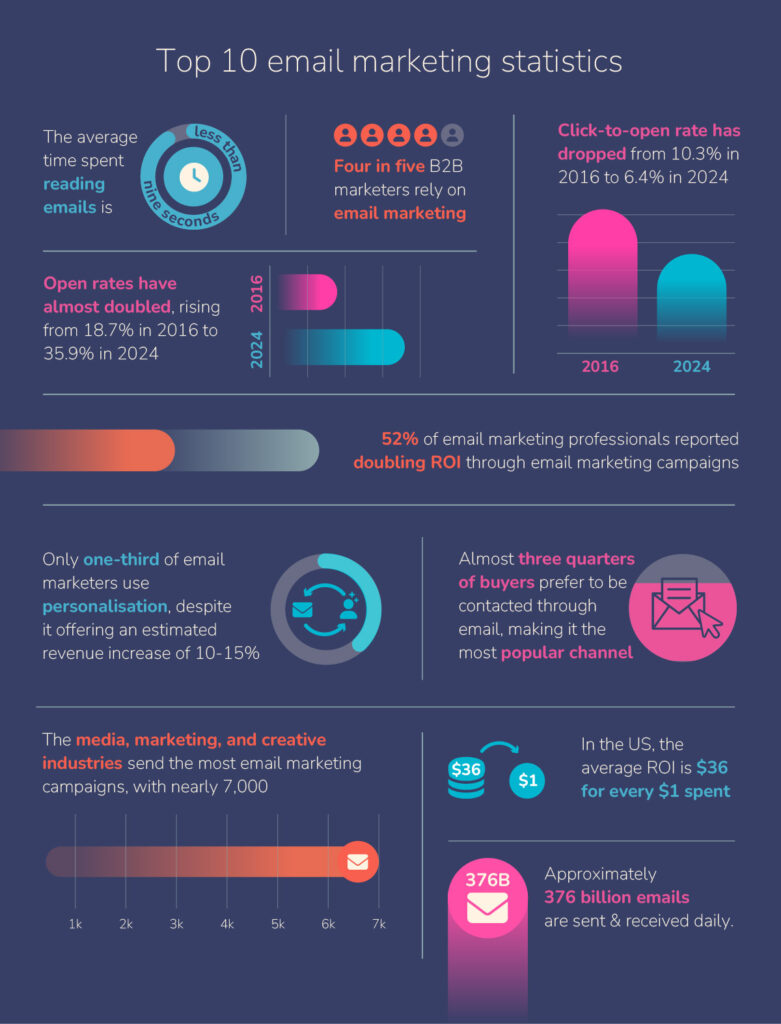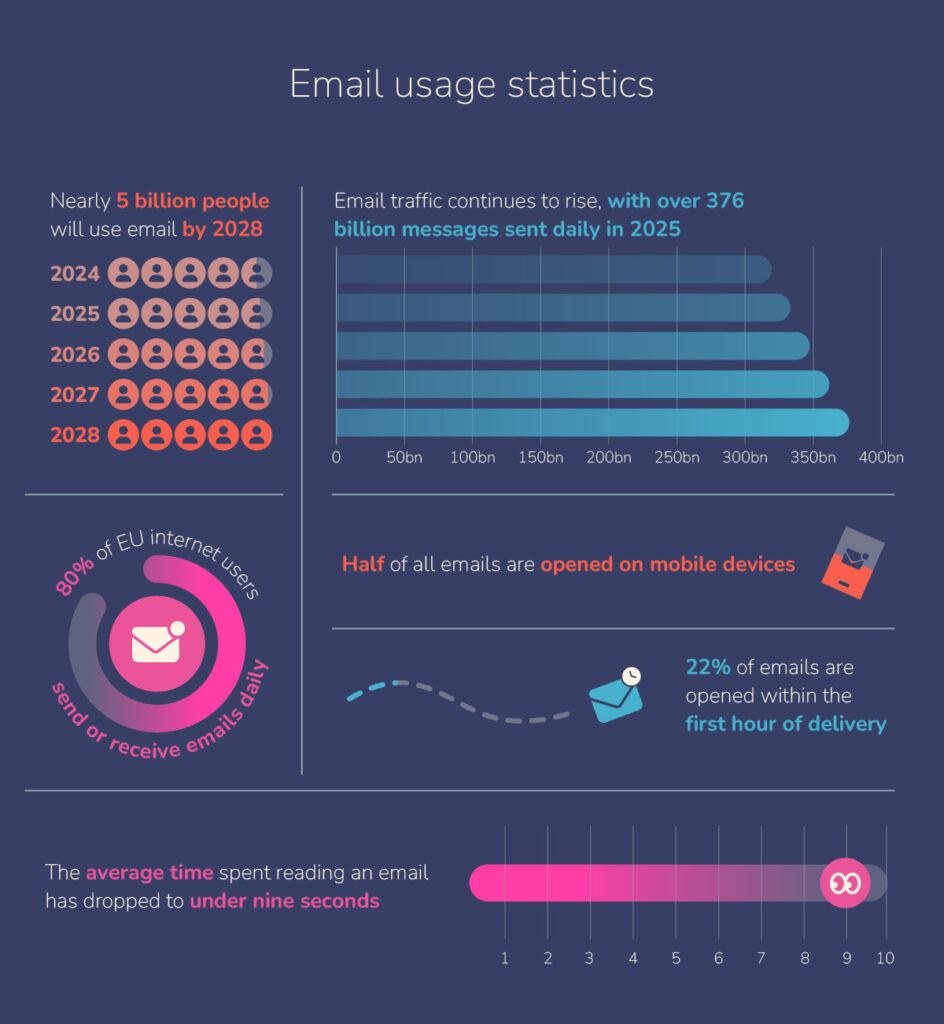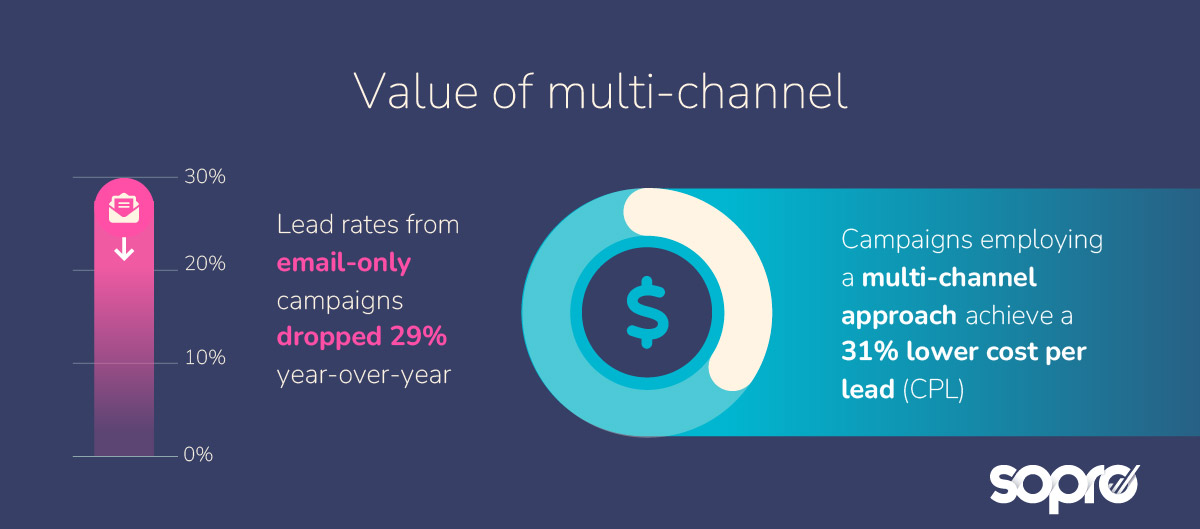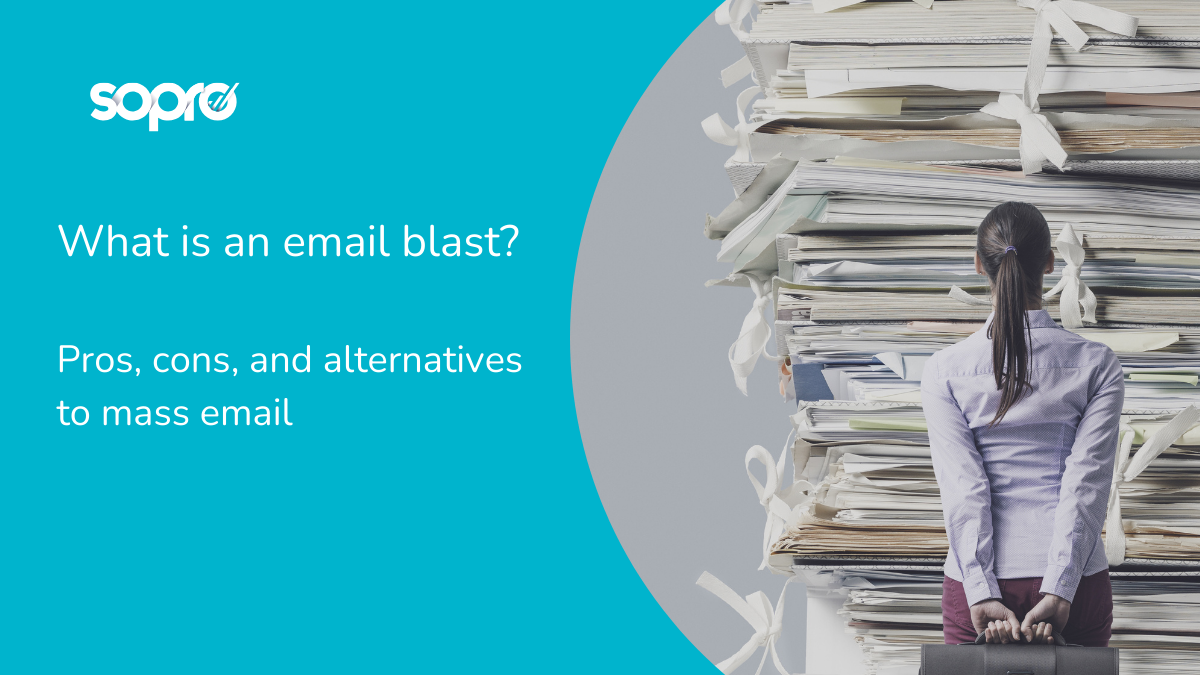43 B2B email marketing statistics and trends

Email remains the most direct, measurable, and reliable channel in B2B marketing, but it’s evolving fast. Once a simple outreach tool, it has evolved into a sophisticated ecosystem driven by data, automation, and intent. For most businesses, it’s no longer a question of whether to use email, but how well they’re using it.
As a B2B email marketing agency, Sopro has witnessed firsthand the transformation of the role of email. Inboxes are more competitive, buyers are more selective, and expectations are higher than ever. Success now depends on precision: the right message, to the right contact, at the right time – delivered with the insight and personalisation that only a data-driven strategy can achieve.
In this report, we break down the latest email marketing statistics for 2025, including engagement benchmarks and ROI performance, as well as the rise of AI-assisted targeting and multi-channel integration.
Top 10 email marketing statistics

- The average time spent reading emails is less than nine seconds. → Read more
- Four in five B2B marketers rely on email marketing. → Read more
- Click-to-open rate has dropped from 10.3% in 2016 to 6.4% in 2024. → Read more
- Open rates have almost doubled, rising from 18.7% in 2016 to 35.9% in 2024. → Read more
- 52% of email marketing professionals reported doubling ROI through email marketing campaigns. → Read more
- Only one-third of email marketers use personalisation, despite it offering an estimated revenue increase of 10-15%. → Read more
- Almost three-quarters of buyers prefer to be contacted through email, making it the most popular channel. → Read more
- The media, marketing, and creative industries send the most email marketing campaigns, with nearly 7,000. → Read more
- In the US, the average ROI is $36 for every $1 spent. → Read more
- Approximately 376 billion emails are sent and received daily. → Read more
Email usage statistics

Before diving into benchmarks and ROI, it’s worth taking a step back to appreciate just how integral email is to both businesses and daily seller-to-buyer communications.
Despite the rise of social media, instant messaging, and AI-driven chat platforms, email’s global footprint continues to grow, proving it’s still the most reliable channel for reaching decision-makers directly.
1. Nearly 5 billion people will use email by 2028
| Worldwide email users | ||||
| 2024 | 2025 | 2026 | 2027 | 2028 |
| 4.48bn | 4.59bn | 4.73bn | 4.85bn | 4.97bn |
Global email users are forecasted to increase from 4.48 billion in 2024 to 4.97 billion by 2028, reaching over 60% of the global population by 2028. In these four years, the growth is estimated to be almost half a billion users.
This sustained growth reinforces email’s unique universality: it’s the only communication platform that transcends industries, devices, and demographics. Email remains the one channel every professional uses, making it a valuable tool for a B2B email marketing agency. New tools will come and go, but your audience will always have an inbox, and that reliability is what gives email its staying power.
2. Email traffic continues to rise, with over 376 billion messages sent daily in 2025
| Daily worldwide email traffic | ||||
| 2021 | 2022 | 2023 | 2024 | 2025 |
| 319.6bn | 333.2bn | 347.3bn | 361.6bn | 376.4bn |
The volume of global email traffic is projected to hit 376 billion emails per day in 2025, up from 361 billion the previous year. That’s roughly 4.3 million emails every second.
This sheer scale shows both opportunity and competition. B2B marketers aren’t just fighting for attention, but they’re competing for milliseconds of cognitive bandwidth in overcrowded inboxes. Standing out in this environment means embracing personalisation, strategic timing, and multi-channel sequencing to reinforce your message beyond a single send.
3. 80% of EU internet users send or receive emails daily
Four in five European internet users send or receive emails regularly. Despite shifts toward instant messaging apps, email remains the cornerstone of professional and commercial communication across the continent.
This makes Europe a mature, high-value market for a B2B multi-channel email marketing agency, and the quality of outreach, precision of targeting, and compliance (particularly under GDPR) can significantly impact performance.
4. Half of all emails are opened on mobile devices
Almost half of all email opens now occur on mobile devices, compared to 27.5% via webmail and 21.2% on desktops.
Mobile’s dominance has profound implications for design and strategy. Emails that aren’t mobile-optimised risk losing engagement before a subject line is even read. For B2B marketers, that means concise copy, clear CTAs, and responsive layouts aren’t optional – they’re essential.
5. The average time spent reading an email has dropped to under nine seconds
| Average time spent reading emails (secs) | |||
| 2018 | 2020 | 2021 | 2022 |
| 13.40 | 11.80 | 10.00 | 8.97 |
The average time readers spend viewing an email has fallen from 13.4 seconds in 2018 to just 8.97 seconds in 2022. That’s a 33% reduction in attention span over four years. Marketers now have less than ten seconds to grab attention, communicate value, and inspire action.
Effective campaigns prioritise clarity over creativity, leading with relevance, front-loading key messages, and relying on clean, digestible layouts to convey the point quickly.
6. 22% of emails are opened within the first hour of delivery
Timing remains crucial. Over one in five opens occur within the first hour after sending, suggesting that optimising send time can directly influence engagement rates.
Your audience is spread across multiple time zones, reinforcing the importance of data-driven scheduling. This involves understanding when your recipients are most active, not just when your CRM is ready to send.
Key takeaway
Email is expanding in reach, volume, and influence. Yet, as inboxes grow noisier, success depends less on whether you send emails and more on how intelligently you do it.
Mastering personalisation, timing, and relevance is vital if B2B brands want to stay visible in a world where attention spans last fewer than ten seconds.
Email marketing industry statistics
Email marketing isn’t just surviving. It’s thriving. Across industries, businesses continue to invest in email as a core marketing tool. The following statistics illustrate its widespread use, evolution as an outreach channel, and where marketers are allocating their resources.
1. The global email marketing industry is now worth over $22 billion
The global email marketing market is worth $22.16 billion, with continued growth anticipated in the years ahead. Email marketing has evolved from a simple communication tool into a fully-fledged industry. Today, it’s where creativity, data, and compliance intersect. And that makes it indispensable for serious B2B growth.
This figure emphasises the sustained investment businesses are making in email as a channel, from campaign technology and automation platforms to data management and compliance tools..
2. Four in five B2B marketers rely on email
Email remains the go-to channel for professional outreach, with 81% of B2B marketers incorporating email into their marketing strategies.
Email is one of the few marketing channels that can directly reach decision-makers, foster long-term relationships, and integrate seamlessly with CRM and automation platforms. It’s the workhorse behind most B2B lead generation and nurturing programmes.
3. Almost three in four B2B buyers prefer to be contacted by email
| B2B buyers’ preferred way to contact prospects | |
| 73% | |
| Phone | 39% |
| Events | 31% |
| Ads | 25% |
| Text | 19% |
| Mail (Print) | 19% |
| Chat (Bot/Live) | 6% |
When it comes to how B2B buyers want to be contacted, email dominates the list. This preference is critical. In B2B, outreach that aligns with how buyers actually want to engage is far more likely to deliver conversions.
Email wins because it gives prospects control over their communication. They can read, respond, or forward a message on their own terms, showing why email is both high-impact and low-friction.
Key takeaway
The email marketing industry is big, growing, and central to B2B commerce. Most marketers use it, and most buyers prefer it, making it the go-to for results-driven prospectors.
Far from fading, email remains a vital channel for business communication, continuing to prove its value as the most direct, measurable, and scalable means of communication.
Email marketing benchmarks
Performance benchmarks are the heartbeat of email strategy. They help marketers understand what ‘good’ looks like, track campaign health, and identify areas for improvement.
1. Average open rates have surged to 35.9%, but the metric is less meaningful than ever
Email open rates have climbed significantly over the past decade, rising from 18.7% in 2016 to 35.9% in 2024.
| Year | Open rate |
| 2016 | 18.7% |
| 2017 | 18.9% |
| 2018 | 21.2% |
| 2019 | 19.6% |
| 2020 | 19.0% |
| 2021 | 19.0% |
| 2022 | 31.8% |
| 2023 | 33.5% |
| 2024 | 35.9% |
On paper, that appears to be a huge success. In practice, it’s largely the result of privacy-related changes, notably Apple’s Mail Privacy Protection (MPP), which began registering automatic ‘opens’ regardless of whether a person viewed the message.
That means open rates now show inbox delivery and technical detection more than true engagement. They’re still useful for spotting anomalies (like a deliverability issue), but less reliable as a success metric.
The real measure of performance is what happens next. Clicks, conversions, replies, and revenue are all better metrics of success.
2. Click rates have remained low, but stable, at around 2% for the last 10 years
Unique click rates have remained consistently around 2% for nearly a decade, demonstrating remarkable stability despite increasing email volumes and audiences.
| Year | Unique click rate |
| 2016 | 1.9% |
| 2017 | 1.9% |
| 2018 | 2.4% |
| 2019 | 2.3% |
| 2020 | 2.0% |
| 2021 | 1.5% |
| 2022 | 1.6% |
| 2023 | 1.9% |
| 2024 | 2.3% |
That stability suggests two key points: first, audiences remain selective about what they engage with; and second, email marketers have improved their targeting and content relevance enough to maintain performance despite increased competition for attention.
A 2-3% click rate remains a strong benchmark, provided those clicks come from the right accounts, not just the right number of accounts.
3. Click-to-open rates have fallen to 6.4%, as inbox behaviour changes
Click-to-open rates (CTOR), the share of recipients who click after opening an email, have declined from 10.3% in 2016 to 6.4% in 2024.
| Year | Click-to-open rate |
| 2016 | 10.3% |
| 2017 | 10.2% |
| 2018 | 11.4% |
| 2019 | 11.7% |
| 2020 | 11.3% |
| 2021 | 9.9% |
| 2022 | 4.8% |
| 2023 | 6.2% |
| 2024 | 6.4% |
This downward shift is tied to the same privacy and behavioural trends that inflated open rates. With inflated opens, CTOR naturally falls. But it also reveals the growing number of people consuming emails passively, scanning on mobile or previewing content without clicking through.
The solution isn’t to chase higher CTORs, but to make every interaction count. Clear CTAs, hyper-relevant content, and seamless landing-page experiences convert curiosity into measurable intent.
Key takeaway
Benchmarking is only valuable if you measure what matters. Open rates have become a signal of deliverability, not engagement. Clicks remain the clearest measure of intent, and conversion or reply rates are where true performance lives.
Email marketing statistics by industry
Every sector uses email differently. Frequency, messaging style, and audience expectations all shape performance, which means benchmarks vary widely by industry. Understanding how your campaigns compare to those of your peers helps set realistic goals and identify where optimisation will have the biggest impact.
| Rank | Industry | Campaigns | Total engagements (businesses & prospects) | Intent generated | Intent rate | Leads generated | Lead rate |
| 1 | Government, Nonprofit & Social | 3,964 | 870,020 | 7,089 | 5.48% | 4,301 | 3.32% |
| 1 | Energy & Environment | 1,760 | 907,823 | 7,947 | 5.63% | 4,690 | 3.32% |
| 3 | Construction & Engineering | 3,850 | 2,909,576 | 25,844 | 5.67% | 13,574 | 2.98% |
| 4 | Manufacturing & Industry | 5,761 | 1,558,599 | 12,788 | 5.23% | 6,463 | 2.64% |
| 5 | Education & Training | 2,768 | 1,321,906 | 7,752 | 3.92% | 4,850 | 2.45% |
| 6 | Agriculture & Food | 2,641 | 1,098,865 | 7,395 | 4.59% | 3,769 | 2.34% |
| 7 | Logistics & Transportation | 3,068 | 1,319,945 | 9,627 | 4.76% | 4,494 | 2.22% |
| 8 | Travel, Leisure & Hospitality | 4,398 | 1,369,462 | 10,439 | 4.66% | 4,660 | 2.08% |
| 9 | Real Estate & Property | 915 | 612,266 | 3,786 | 3.73% | 1,883 | 1.85% |
| 10 | Healthcare | 4,148 | 2,751,227 | 15,003 | 4.10% | 6,626 | 1.81% |
| 11 | Professional Services | 5,296 | 1,291,749 | 8,991 | 4.04% | 3,903 | 1.75% |
| 12 | Media, Marketing & Creative | 6,717 | 1,599,408 | 9,101 | 3.28% | 4,741 | 1.71% |
| 13 | Finance & Banking | 3,882 | 2,803,830 | 21,998 | 6.01% | 6,052 | 1.65% |
| 14 | Consumer & Retail | 5,949 | 2,064,550 | 12,546 | 3.95% | 4,998 | 1.57% |
| 15 | Computers & IT | 4,769 | 3,094,285 | 16,598 | 3.32% | 6,610 | 1.32% |
1. Government, Nonprofit & Social industries achieve a 3.32% lead rate
The public and nonprofit sectors achieve standout results, with campaigns generating a 5.48% intent rate and a 3.32% lead rate. These strong outcomes reflect the trust email commands in mission-driven communication. As an award-winning B2B lead generation agency, we know that clarity, transparency, and value-based messaging are essential for driving growth, with audience engagement resting on relevance rather than promotion.
2. Energy and environment campaigns record a 3.32% lead rate and a 5.63% intent rate
Campaigns across the energy and environment space continue to perform exceptionally well, converting sustainability-focused messaging into tangible engagement. The sector’s strength lies in educational, purpose-led content, a clear example of how thought leadership and social impact can translate directly into commercial opportunity.
3. Construction and engineering deliver a 5.67% intent rate
Construction and engineering campaigns show one of the highest levels of engagement, with 25,844 intents generated from 3,850 campaigns. Long sales cycles and relationship-driven communication make email a crucial tool for maintaining visibility throughout the decision-making process. Technical updates, project showcases, and case-led storytelling drive sustained interest.
4. Travel, leisure, and hospitality campaigns convert at a 2.08% lead rate
The travel and leisure sector continues to recover strongly, with campaigns producing 10,439 intents and 4,660 leads. The 4.66% intent rate highlights how personalisation and timing remain key drivers of engagement.
5. Finance and banking achieve the highest intent rate at 6.01%
Financial services and banking campaigns deliver 21,998 intents and 6,052 leads, leading all industries for engagement quality. A 6.01% intent rate confirms how credibility and precision elevate performance in a high-trust environment. Clear, data-backed messaging and regulatory confidence continue to set the standard for financial communication.
6. Computing and IT generate over 3 million engagements, but a 1.32% lead rate
Computing and IT campaigns earn the most total engagements of any sector, with 3.09 million total. However, lead conversion remains relatively modest at 1.32%. The data indicates that while awareness is high, nurturing remains critical. Automated journeys and content sequencing can help translate strong top-of-funnel performance into measurable pipeline results.
Working in IT? We’ve got you covered. Explore expert lead generation services for IT businesses and start seeing growth.
7. Media, marketing, and creative industries sent the most campaigns, with 6,717
Email continues to deliver solid performance for the media, marketing, and creative industries, achieving a 3.28% intent rate and a 1.71% lead rate across over 6,700 campaigns. These figures reflect the sector’s maturity in using content-led outreach to build trust and sustain engagement over time.
For agencies and creative businesses, email remains both a commercial and a brand-building tool. Campaigns often blend thought leadership, industry insights, and portfolio highlights, with content designed to educate and inspire as much as to convert. The results show that when creativity meets data, audiences respond with meaningful engagement, even if conversion rates remain modest compared to more product-led sectors.
Key takeaway
Across every industry, email continues to prove its adaptability and impact, consistently generating both intent and conversion at scale. From public sector engagement to financial trust and technical education, the most successful sectors all share one principle: relevance. The closer a campaign aligns with its audience’s goals and motivations, the stronger the outcomes.
Email marketing statistics by region
Email marketing is a truly global discipline, but engagement, volume, and performance vary widely depending on where your audience is located. Regional trends reveal how cultural preferences, regulatory frameworks, and levels of digital maturity influence campaign outcomes.
The leading countries by email marketing campaigns
Volume is a great indicator of which countries are utilising email marketing. Although it’s not a great metric for success, it does provide insight into which countries are investing in email marketing and where residents are responding.
| Rank | Country | Region | Total campaigns |
| 1 | Germany | Europe | 1,349,308 |
| 2 | Hong Kong | APAC | 835,811 |
| 3 | United Kingdom | Europe | 832,328 |
| 4 | United States | North America | 477,906 |
| 5 | France | Europe | 475,790 |
| 6 | Netherlands | Europe | 386,525 |
| 7 | Australia | APAC | 253,168 |
| 8 | Austria | Europe | 231,473 |
| 9 | Belgium | Europe | 195,906 |
| 10 | Argentina | South America | 178,345 |
1. Europe dominates global email output, with almost 3.5 million campaigns
Email marketing activity varies significantly around the world, shaped by each region’s digital maturity, regulatory landscape, and appetite for direct communication. Europe has the most campaigns, with over 3.4 million campaigns sent, whereas APAC and North America continue to expand their presence as automation and CRM adoption accelerate.
2. Germany leads worldwide campaign volume, with over 1.3 million campaigns
Germany leads the world in email campaign volume, with over 1.34 million campaigns sent in the most recent reporting period. The United Kingdom and France follow closely, each delivering more than 800,000 and 475,000 campaigns, respectively.
The level of activity across Europe truly showcases the region’s advanced marketing scene. It’s built on strong compliance standards and a genuine trust in email as a go-to communication channel.
3. The UK sends over 830,000 email campaigns a year
The United Kingdom remains one of the most active and advanced email marketing ecosystems globally, sending more than 832,000 campaigns annually. That volume places the UK just behind Germany and Hong Kong, highlighting its deep integration of email across both B2B and B2C strategies.
4. The US delivered half a million campaigns in 2024
The United States generates 478,000 email campaigns annually, ranking fourth globally in terms of total volume. While this figure is smaller than that of leading European markets, it reflects a deliberate focus on quality and efficiency over scale.
Unlike many regions, where volume signals dominance, the American approach prioritises data-driven optimisation, message testing, and behavioural triggers. This emphasis on precision ensures that fewer emails produce stronger outcomes, turning engagement into conversion and conversion into loyalty.
Across regions, the average click-to-open ratio is 4.65%
Engagement paints a better picture than volume when it comes to measuring the success of email marketing campaigns. Regional click-through rates reveal where audiences are most responsive to email content, and where marketers are mastering relevance and timing.
| Rank | Country | Region | CTR |
| 1 | Netherlands | Europe | 6.0% |
| 1 | Canada | North America | 6.0% |
| 3 | Norway | Europe | 5.5% |
| 4 | Denmark | Europe | 4.6% |
| 6 | United Kingdom | Europe | 4.5% |
| 6 | Belgium | Europe | 4.5% |
| 6 | Portugal | Europe | 4.5% |
| 9 | Bulgaria | Europe | 4.3% |
| 10 | Germany | Europe | 3.3% |
| 10 | France | Europe | 3.3% |
1. Europe and Canada lead on engagement with a 60% CTR
Engagement levels reveal a different kind of leaderboard. While Europe dominates total campaign volume, it also produces some of the world’s most engaged audiences. The Netherlands and Canada jointly top the charts with an average click-through rate of 6.0%, setting a high bar for performance.
2. Northern Europe shows exceptional consistency, with a CTR of around 5%
Close behind are Norway (5.5%), Denmark (4.6%), Belgium (4.5%), and Portugal (4.5%), a cluster of mature, digitally fluent nations where marketing practices are well-optimised and data protection frameworks have driven greater message relevance.
Even in markets with more conservative communication habits, such as Germany and France, engagement holds steady at around 3.3%, illustrating a stable foundation of trust between sender and recipient.
Key takeaway
This regional variation points out a core truth about email performance: higher engagement is rarely a result of volume. The countries achieving the best CTRs are those that emphasise segmentation, timing, and personalisation over sheer frequency.
Statistics on email marketing ROI and costs
Email marketing continues to outperform almost every other digital channel in terms of measurable return. It’s efficient, direct, and built for scale. However, the real story lies in just how consistently strong that ROI remains across countries and industries.
1. Email delivers exceptional returns across markets, with an average ROI of $36 per dollar spent
In the United States, email marketing generates an average of $36 in revenue for every $1 spent, maintaining its long-standing position as one of the most profitable marketing channels.
While costs vary by region and technology stack, email’s underlying efficiency remains largely unchanged. Its ability to nurture leads and drive sales without heavy media spending or third-party dependency keeps it at the centre of most B2B strategies.
2. Across Industries, nearly two-thirds (63%) of B2B marketers say that email prospecting returns an excellent or very good level of ROI
The financial impact of email marketing varies across sectors, but every industry continues to see a substantial return on investment. From high-frequency retail campaigns to precision-targeted B2B communication, email remains one of the most efficient revenue drivers available to marketers today.
| % who said email prospecting returns an excellent / very good level of ROI | |
| Channel | Excellent / Very Good |
| IT / Telecoms | 73% |
| Marketing | 69% |
| Industrials | 61% |
| Retail / Wholesale | 56% |
| Business / Financial services | 55% |
3. IT and Telecoms lead with 73% rating email ROI as excellent or very good
According to insights gathered during research for Sopro’s latest State of Prospecting report, IT and telecommunications firms report the highest returns, with 73% rating email ROI as excellent or very good, a clear reflection of a digitally advanced, data-rich environment.
Decision-makers are used to evaluating solutions through digital channels, and email aligns perfectly with their research-driven purchasing process. Campaigns that focus on pain points like efficiency, scalability, and innovation perform particularly well, converting technical credibility into qualified leads.
4. Almost seven in 10 marketing professionals report strong ROI from email prospecting
Marketing professionals closely follow at 69%, demonstrating the effectiveness of data-rich, segmented campaigns in the creative industries. It’s no surprise that a sector built on audience insight and creative communication excels at its own outreach.
This success reflects the agency world’s reliance on relationship management and the need to consistently inform clients and prospects. Effective email campaigns in this sector are typically value-driven, featuring thought leadership, insights, and results updates.
5. Industrial sectors achieve a strong ROI rating, with three in five reporting an excellent or very good ROI
The industrial and manufacturing sectors demonstrate that targeted, steady communication is effective, with 61% of respondents in these industries rating their email ROI as excellent or very good. This high ROI is a testament to consistency and focus in long-cycle B2B sales.
For these businesses, email remains an essential tool for maintaining visibility across extended procurement processes. Campaigns that educate, inform, and reassure are more effective than an aggressive sales approach.
6. More than half of marketing professionals report that email campaigns doubled their ROI
The channel’s profitability isn’t static; it’s accelerating. Over half of email professionals (52%) reported that their campaign ROI doubled between 2022 and 2023.
This rapid improvement highlights the impact of smarter segmentation, enhanced data hygiene, and streamlined automation workflows. As platforms integrate AI-driven optimisation and predictive analytics, email’s ability to convert attention into revenue only grows stronger.
7. ROI quadrupled between 2022 and 2023 for 5.7% of businesses
A small share of markets reported that their ROI quadrupled over the same period. While a minority, this segment illustrates what’s possible when teams fully embrace automation, dynamic content, and end-to-end integration with CRM systems.
Marketers who invest in relevance and automation could see exponential returns. It’s no longer about how many emails you send. It’s about how intelligently each one is timed, written, and targeted.
8. 63% of UK businesses rate email as delivering excellent ROI
In the UK, 63% of businesses say email prospecting provides an excellent or very good level of ROI, comfortably outperforming every other channel. The nearest competitors, warm calling (49%) and social media (45%), trail significantly behind. Even established outreach methods, such as direct mail (41%) and LinkedIn InMails (38%), fail to match the efficiency or consistency of email.
This dominance reflects the UK’s advanced data and compliance environment. GDPR-driven practices have forced marketers to prioritise quality, consent, and relevance. This transforms email from a mass-send tactic into a precision channel that builds trust and converts efficiently.
9. In the US, email remains the top ROI performer at 54%
Across the Atlantic, 54% of US businesses also rank email as the most effective prospecting channel for ROI, narrowly beating warm calling (53%) and outperforming all other methods. Channels like social media (49%) and direct mail (41%) remain valuable for brand reinforcement, but they lack the directness and scalability of email.
10. Email MQL conversion rate is 11.3% higher compared to the blended average
While ROI paints the broad picture, email’s role in the funnel is equally revealing. Email contributes roughly 1.3% of total marketing-qualified leads (MQLs), accounting for 2.24% of revenue in B2B environments. Those leads convert 11.3% faster than the blended average and move through the sales cycle 7% quicker than inbound leads overall.
| % of email marketing professionals | |
| Email contribution to MQLs | 1.30% |
| Email MQL contribution to revenue | 2.24% |
| Email MQL conversion rate compared to blended average | 11.3% higher |
| Email MQL sales cycle compared to inbound average | 7% faster |
This efficiency matters. Email accelerates decision-making by keeping prospects informed, engaged, and moving steadily through the pipeline. It’s not always the largest contributor to lead volume, but it consistently produces higher-quality, sales-ready contacts that convert more efficiently.
Key takeaway
Email’s ROI story is one of consistency and evolution. It remains one of the most cost-effective channels in existence, but the best results come from those who treat it strategically, combining personalisation, automation, and clear commercial intent.
In 2025 and beyond, the marketers seeing the biggest gains will be those who recognise that email marketing is one part of a bigger picture. Sopro’s State of Prospecting research reveals that multi-channel prospecting, where email plays an instrumental role, delivers the best results – far beyond what single-channel outreach can offer.
Personalisation in email marketing statistics
Personalisation has become one of the defining factors of modern email performance. In a market saturated with automation and templated messaging, the ability to deliver relevance at scale is now a major differentiator, both in engagement and revenue impact.
| Estimated increase from personalisation | |
| Revenue (overall) | 10-15% |
| Revenue (firm-specific) | 5-25% |
| Open rate | 20% |
| Click rate | 139% |
1. Personalisation drives measurable revenue growth of between 10 and 15%
Getting personalisation right directly translates into stronger business performance. Studies show it can increase overall revenue by 10-15%, with firm-specific improvements ranging from 5% to 25% depending on the maturity of a company’s data strategy.
This revenue lift indicates more than just higher engagement. Personalised emails nurture trust and relevance, leading to longer-term customer value and faster buying decisions. Both are critical in complex B2B cycles.
2. Engagement rates skyrocket with personalised campaigns, with an open rate of 20%
From an engagement perspective, the uplift is dramatic. Personalised email campaigns achieve 20% higher open rates and a remarkable 139% higher click rate compared to non-personalised sends.
These figures illustrate a fundamental truth: audiences are more likely to act when messages align with their needs, context, or behaviour. The combination of behavioural triggers, tailored content, and dynamic personalisation creates a compounding effect, driving engagement further with each interaction.
3. Only a third of marketers fully leverage personalisation
Despite its proven impact, adoption remains limited. Just 36% of email marketers currently use personalisation effectively in their campaigns.
The gap between potential and practice is striking, especially in B2B, where granular data often exists but isn’t fully harnessed. Many teams still rely on basic segmentation or first-name tokens rather than truly dynamic personalisation based on intent, firmographics, or buyer journey stage.
4. 71% of audiences now expect email personalisation by default
The demand for personalisation is no longer optional; it’s a baseline expectation. 71% of consumers now expect brands to deliver personalised experiences, while 76% say they feel frustrated when that expectation isn’t met.
In B2B, that frustration often manifests as disengagement or unsubscribe behaviour. Buyers are busy, selective, and empowered, and irrelevant emails erode trust faster than almost any other channel. Marketers who fail to tailor their outreach risk being filtered out both digitally and mentally.
Key takeaway
Personalisation has moved from a competitive advantage to a performance necessity. It drives double-digit revenue gains, multiplies engagement, and shapes buyer perception, yet most brands still underutilise it.
The opportunity lies not just in using personalisation, but in using it intelligently: combining behavioural insights, automation, and human relevance to deliver messages that truly resonate.
Email marketing vs. other channels

Email remains the channel of choice for most B2B buyers, but the broader performance landscape is shifting. While email still outperforms most other channels in terms of accessibility and direct engagement, multi-channel approaches are proving even more effective at driving high-quality leads at a lower cost.
| Preferred way of hearing from sellers | |
| 73% | |
| Telephone | 49% |
| In-person event | 38% |
| Social Media | 28% |
| Conferences/Webinars | 22% |
| Word of mouth | 20% |
| Post/Direct mail | 17% |
1. Email is still the most preferred way to hear from sellers
When asked how they prefer to be contacted by sales teams, 73% of buyers chose email, comfortably ahead of all other methods. Telephone contact followed at 49%, with in-person events (38%), social media (28%), and webinars or conferences (22%) trailing further behind.
This preference reinforces email’s long-standing role as the cornerstone of B2B communication. It offers buyers control, flexibility, and a sense of professionalism that other channels can struggle to match. In a world of constant digital noise, email remains the space where decision-makers are most willing to engage, provided the outreach is targeted, relevant, and respectful of their time.
2. Single-channel outreach is losing traction, with lead rates from email-only campaigns dropping 29% YoY
Despite this dominance, reliance on email alone is showing diminishing returns. Lead rates from email-only campaigns dropped 29% year-over-year, indicating a growing fatigue among audiences exposed to repetitive, one-dimensional outreach.
As inbox competition intensifies, even high-quality campaigns risk being overlooked when they operate in isolation. The data suggests that while email continues to perform, it now works best as part of a broader, integrated strategy rather than a standalone channel.
3. Multi-channel strategies increase effectiveness with a 31% lower cost-per-lead (CPL)
The advantages of diversification are clear. Campaigns employing a multi-channel approach achieve a 31% lower cost per lead (CPL) compared to those relying on a single channel. This cost efficiency highlights the compounding power of combining email with supporting channels, such as social media, phone, and events, each reinforcing awareness, trust, and response rates.
In practice, that means a single email may start the conversation, but it’s often a social follow-up, remarketing ad, or well-timed call that converts it into an opportunity. The data shows that integrated outreach doesn’t just improve conversion efficiency; it also reduces overall acquisition costs by ensuring that each channel plays to its strength within the funnel.
Key takeaway
Email remains the most preferred and effective communication channel in B2B marketing, but not in isolation. The highest-performing campaigns now pair their precision and reach with complementary channels that amplify engagement and reduce costs.
Future email marketing trends: Sopro’s predictions
The next evolution of B2B email marketing won’t be defined by volume. Instead, we expect it will be shaped by precision, intelligence, and trust. As inboxes become increasingly competitive and automation becomes more widespread, success will depend on how effectively businesses combine data, creativity, and compliance to deliver meaningful communication at scale.
Inbox saturation is driving a shift toward quality over quantity
B2B inboxes are overflowing. AI-driven mass outreach has accelerated send volumes, while stricter spam filtering is eroding visibility and engagement. The future belongs to marketers who respect the inbox. Those who prioritise audience fit, timing, and value over frequency. Quality is becoming the new currency of attention.
Success will depend on precision, not volume
The era of blanket outreach is coming to an end. Winning teams will focus on data accuracy, message clarity, and strategic timing, and delivering fewer, better-targeted emails will earn responses. Campaigns built on verified data and thoughtful sequencing will consistently outperform indiscriminate mass sends.
Smarter coverage will uncover hidden opportunities
Most outbound programmes still reach only a fraction of their total addressable market. Advances in AI-driven intent data and live list-building will soon allow marketers to map entire buying groups, not just final decision-makers. The next generation of prospecting will connect with every relevant stakeholder in the purchase journey, broadening reach and improving conversion rates.
Relevance will become the ultimate differentiator
Buyers expect outreach that understands their context, goals, and challenges. Personalisation will move beyond name fields and job titles to reflect industry, intent signals, and business priorities. Achieving this at scale will depend on the balance between AI augmentation and human insight, blending automation with empathy to deliver genuinely relevant communication.
Always-on consistency will replace campaign bursts
Stop–start outreach creates pipeline gaps and lost momentum. The future of email marketing is always-on visibility, and continuous, steady communication will keep brands present throughout long sales cycles. Consistent, multi-touch engagement consistently outperforms sporadic campaign pushes.
AI will augment, not replace, human creativity
AI is already transforming outbound teams, helping to refine targeting, generate copy, and optimise send sequences. However, the best-performing models will remain human-led and AI-assisted, utilising automation to streamline administration while preserving authenticity, tone, and empathy. The future of outbound lies in a partnership between machine intelligence and human judgment.
Multi-channel coordination will define performance
Email will remain the preferred channel for buyers, but its true potential will come from integration. Campaigns that align email with LinkedIn, phone, and inbound activity will deliver stronger engagement and brand recall. The future is connected outreach, consistent messaging across every touchpoint, tailored to where each buyer is in their journey.
Deliverability will evolve into a strategic discipline
As email providers tighten anti-spam controls, technical excellence will become a competitive advantage. Teams will need to manage domains, warm-up routines, and sending patterns with precision. Deliverability will move beyond compliance to become a strategic performance lever, ensuring that great content actually reaches its audience.
Trust and compliance will underpin sustainable success
Credibility is now a core performance metric. Buyers judge the legitimacy of outreach based on how relevant, consistent, and compliant it feels. The brands that thrive will be those that combine transparency, accurate data, and regulatory discipline to build trust over time. In an age of automation, authenticity remains the most powerful differentiator.
Expert Q&A about B2B email marketing
How is AI impacting B2B email marketing?
AI is transforming B2B email marketing from a numbers game into a precision tool. It’s not about replacing marketers, though; it’s about empowering them to do their best work at scale.
AI enables smarter targeting, sharper personalisation, and stronger performance. Here at Sopro, we leverage AI tools to help predict which prospects are most likely to engage, optimise send times, and test subject lines to maximise campaign results.
It’s definitely time to see AI as an enhancer, not a disruptor. Emerging technology may drive the insight, but it’s still people – your brand, your voice, your story – that build trust and convert interest into opportunities.
→ Learn more about how Sopro uses AI for generative messaging.
Is automation replacing creativity in email marketing?
Not at all. In fact, it’s giving creativity more space to thrive.
Automation takes care of the manual, repetitive work: scheduling, segmentation, and follow-ups. That frees marketers to focus on what truly matters – understanding audiences, crafting compelling stories, and designing campaigns that resonate on a human level.
At Sopro, we use automation to deliver efficiency, but we never let it dictate tone or message. Creativity is still what makes an email worth opening, reading, and responding to. The best results come from the perfect balance, with data doing the heavy lifting, and creative thinking delivering the spark that earns authentic, high-intent engagement.
How can you prove the ROI of email marketing to stakeholders?
Email marketing ROI is one of the easiest and most compelling stories to tell…when you have the right data.
It starts with setting and aligning on clear objectives. Ask yourself, are you driving leads, nurturing prospects, or generating meetings? Then it’s about tracking what matters to stakeholders and your wider business – response rates, engagement levels, conversions, and, crucially, revenue generated.
At Sopro, we connect email engagement directly to pipeline impact, giving clients the hard evidence they need to demonstrate ROI with confidence. When you can show how every email contributes to real business outcomes, the numbers speak for themselves.
Do email marketing tactics need to adapt in different regions?
Yes, regional nuance can make or break your campaign.
Different markets respond to different tones, formats, and levels of formality. Regulatory environments also vary: what’s compliant in the UK isn’t always so in Germany or the US (read our guide on cold email marketing to learn more about regulations like the GDPR and CAN-SPAM).
If you’re planning multi-national or even global outreach, make sure you do your research in advance and segment your buyer lists like your life depends on it to ensure every message lands effectively.
Sources
- https://www.radicati.com/wp/wp-content/uploads/2020/12/Email-Statistics-Report-2021-2025-Executive-Summary.pdf
- https://ec.europa.eu/eurostat/statistics-explained/index.php
- https://www.litmus.com/blog/email-client-market-share-may-2021
- https://www.litmus.com/blog/trends-in-email-engagement
- https://www.litmus.com/blog/whats-the-best-time-to-send-email-we-analyzed-billions-of-email-opens-to-find-out
- https://www.transparencymarketresearch.com/email-marketing-industry.html
- https://www.forbes.com/advisor/business/software/email-marketing-statistics/
- https://dma.datatile.eu/view/54625cfe-fd37-4374-9412-8cb75ae8218d/abfc14a6a92f4ef2b097e10b625c1e19
- https://dma.datatile.eu/view/54625cfe-fd37-4374-9412-8cb75ae8218d/6164c928387f469197637bfdd615d6da
- https://dma.datatile.eu/view/54625cfe-fd37-4374-9412-8cb75ae8218d/abfc14a6a92f4ef2b097e10b625c1e19
- https://sopro.io/results/live-campaign-results/ (accurate as of 21/10/2025 at 11:02. Industries were manually aggregated into broader groupings)
- https://globaldma.com/international-email-benchmark/
- https://www.statista.com/statistics/1376015/email-roi-improve-rates/
- https://www.hockeystack.com/lab-blog-posts/email-marketing-conversions-and-revenue-in-b2b-saas
- https://www.b2bmarketing.net/email-marketing-revealed-as-having-greatest-impact-on-revenue/
- https://www.mckinsey.com/capabilities/growth-marketing-and-sales/our-insights/the-value-of-getting-personalization-right-or-wrong-is-multiplying?
- https://business.adobe.com/blog/basics/personalized-email
- https://www.litmus.com/blog/email-marketing-personalization-using-data
- https://www.mckinsey.com/capabilities/growth-marketing-and-sales/our-insights/the-value-of-getting-personalization-right-or-wrong-is-multiplying
- https://2271291.fs1.hubspotusercontent-na1.net/hubfs/2271291/








Share